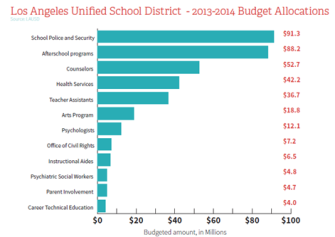Two California groups released a policy brief today that asks school districts in the state to use new funding to lessen the gap in spending between school security and student support and engagement initiatives.
An overreliance on school-based police in many districts, including many that serve large numbers of poor and minority students, has led to overly harsh discipline and too many referrals of students to the justice system, the Los Angeles-based Labor/Community Strategy Center’s Community Rights Campaign and the Oakland-based Black Organizing Project said in the report.
“We have watched our school budgets be increasingly devoted to law-enforcement-based school security strategies at the expense of vital support and educational services that students need,” said the report, called “The New Separate and Unequal: Using California’s Local Control Funding Formula to Dismantle the School-to-Prison Pipeline.”
The report analyzed budgets from many school districts and found that spending on security far overshadowed spending for things like arts programs and parental-involvement initiatives. Here’s the breakdown for Los Angeles schools. It appears the groups calculated the “school police and security” total by adding the budget’s allocations for supervisory “campus aides” ($33.6 million) and for school police ($57.7 million).

Statewide, California has made some progress on the school climate front. In January, the state reported a sharp decline in suspensions and expulsions in the 2012-2013 school year, a trend attributed to changes in district-level policies designed to keep students in the classroom.
Across the Golden State, the total number of expulsions decreased by 12.3 percent, from 9,758 in 2011-12 to 8,562 in 2012-13. The total number of suspensions--either in-school or out-of-school--dropped 14.1 percent, from 709,596 in 2011-12 to 609,471 in 2012-13, the state department of education said.
And today’s report noted promising school policing practices in some districts, some of which occurred after the years represented in the report’s data. Among the highlights:
- “Los Angeles Unified has substantially reduced its use of police tickets and arrests, nearly ceased the criminalization of truancy offenses, instituted a policy to prevent the frequent use ticketing for students ages 12 and under, and passed a School Climate Bill of Rights that commits to defining and limiting the role of school police on campus.”
- “San Francisco Unified strengthened its longstanding agreement to limit police involvement to situations in which: (a) student safety is threatened; (b) the law requires an officer to be involved; or (c) there is criminal activity by non-students on or near school grounds.”
- “Pasadena Unified revised its agreement with the Pasadena Police Department in 2013 to specify that police are to focus on legitimate safety threats and not school disciplinary matters.”
But the groups are urging districts to do more. They point to the state’s new voter-approved Local Control Funding Formula, described here by my colleague Andrew Ujifusa:
The new funding formula eliminates many of the state's traditional categorical funding programs, while providing additional state aid for districts with certain percentages of students who are English-language learners, from low-income families, or living in foster care. The funding scheme, which the state will gradually phase in until 2020, also gradually increases overall state funding for K-12."
In the report, the groups ask the state to explicitly ban the use of addtional funds from the new formula on school-based police and to encourage alternatives to school police. They ask districts to take steps that include investing in evidence-based alternatives to school policing, and hiring additional counselors, psychologists, social workers, nurses, and community intervention workers.
The report is available here.
